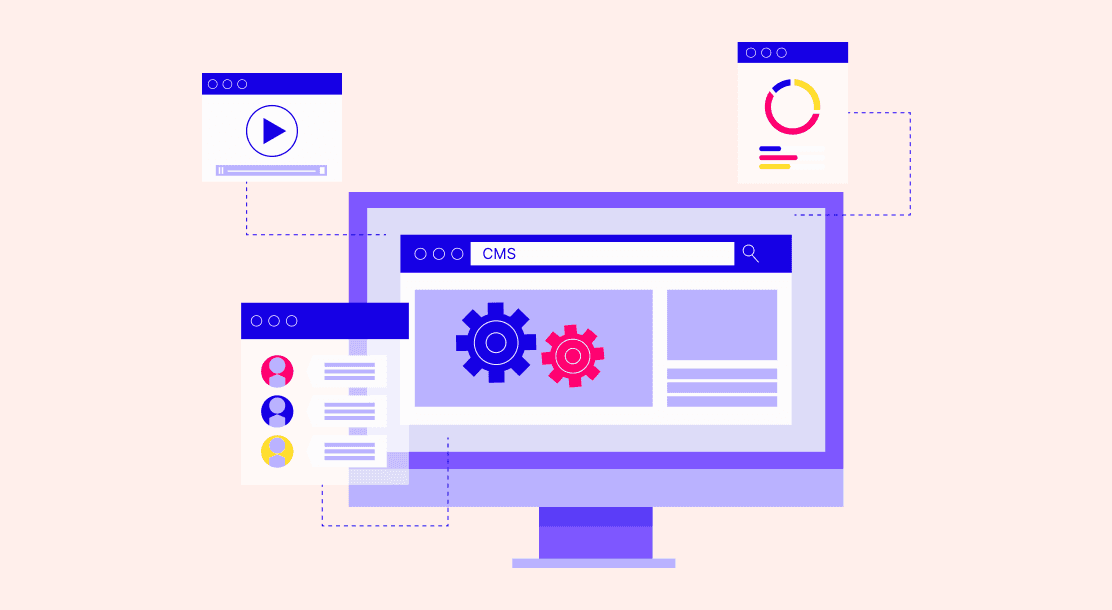8 Benefits of Using a Component Content Management System

A Component Content Management System (CCMS) is a specialized software tool used to create, manage, and publish modular content components. Unlike traditional content management systems (CMS), which typically manage whole documents or pages, a content management system components platform allows for the management of smaller chunks of content, such as paragraphs, images, or videos.
A CCMS content management system allows content creators to break down their content into reusable, independent modules, which can then be assembled and published in various formats, such as web pages, documentation, e-learning modules, and product catalogs. This approach to content creation is often referred to as “single-source” publishing, as it enables organizations to create content once and then publish it in multiple formats.

Alt text: Types of CMS
A component content management platform can also provide advanced features such as content versioning, workflow management, content reuse tracking, translation management, and analytics. These features can help content creators streamline their content production processes and improve their content quality and consistency over time.
8 Benefits of Using a Component Content Management System

Alt Text: CMS Benefits
In the era of digitalization, the importance of content management has increased manifold. With the increasing demand for customized content and the need to deliver it at lightning speed, companies need to have a robust content management system in place.
A content management system components software is designed to enable organizations to manage their content in smaller, reusable components. Instead of managing content in large chunks, a CCMS content management application enables content creators to manage content in smaller, more manageable pieces. These smaller pieces, or components, can then be reused in multiple places throughout an organization’s content ecosystem, leading to increased efficiency and consistency.
Let’s take a closer look at the benefits of using a component content management system:

Alt image: CCMS
1. Increased efficiency
A component content management system enables content creators to manage content in smaller, reusable components, which can then be used across multiple documents. This reduces the amount of time and effort required to create new content, resulting in increased efficiency. With a CCMS content management application, content creators can quickly search for and reuse existing content, rather than recreating it from scratch.
2. Improved consistency
When content is managed in smaller, reusable components, it becomes easier to ensure consistency across all documents. This is because the same content is used across multiple documents, making it easier to update and maintain. In addition, with a component content management system, users can enforce rules around style and formatting, ensuring that all content adheres to the same standards.
3. Reduced risk of errors
With content management system components software, content creators can quickly and easily update content across multiple documents. This reduces the risk of errors, as changes are made in one place and automatically propagated to all instances where the content is used. This also reduces the amount of time and effort required to update content, further reducing the risk of errors.
4. Increased reusability
By managing content in smaller, reusable components, organizations can increase the reusability of their content. This means that the same content can be used in multiple documents, reducing the amount of time and effort required to create new content. In addition, a CCMS can track the usage of components, making it easier to identify and retire content that is no longer needed.
5. Faster time to market
With CCMS content management software, organizations can create and update content faster, reducing the time to market for new products and services. This is because content can be reused across multiple documents, reducing the amount of time and effort required to create new content. In addition, content management system software can help automate the publishing process, further reducing the time required to get content to market.
6. Improved translation management
When content is managed in smaller, reusable components, it becomes easier to manage translations. This is because the same content can be translated once and then reused across multiple documents. In addition, a CCMS can automate the translation process, making it faster and more efficient to translate content into multiple languages.
Insert banner on Pepper’s translation services
7. Better content analytics
With a CCMS content management application, organizations can track the usage of components, making it easier to identify popular content and trends. This information can be used to optimize content for better engagement and conversion rates. In addition, a CCMS can track the performance of content across multiple channels, making it easier to identify which channels are most effective for reaching target audiences.
8. Scalability
As organizations grow and their content needs to increase, a component content management system can be scaled to meet those needs. This is because the content is managed in smaller, reusable components, making it easier to add new content as needed. In addition, a CCMS can be integrated with other systems, such as marketing automation and e-commerce platforms, to further increase efficiency and scalability.
A component content management system (CCMS) is a powerful tool that helps organizations create, manage, and publish content more efficiently. CCMS allows content creators to focus on creating high-quality content while reducing the time and effort required to publish it across multiple channels and platforms.
With CCMS, organizations can improve content reuse, reduce errors, improve collaboration, and increase overall productivity. Content management system components software also provides advanced analytics and reporting capabilities that can help organizations measure the effectiveness of their content and make data-driven decisions to improve it. As a result, a component content management system can be a valuable investment for any organization looking to streamline its content creation and management processes.
FAQs
A CCMS is a software application that manages and organizes content into reusable components. These components can be combined to create different types of content, such as technical documentation, marketing materials, and product catalogs.
Using a CCMS can help organizations streamline their content creation and management processes, reduce costs, and improve the quality and consistency of their content. By organizing content into reusable components, a CCMS can also help organizations create and distribute content more efficiently.
A CCMS can manage a wide variety of content types, including text, images, video, audio, and interactive content. CCMSs are often used for technical documentation, marketing content, and e-learning materials, but they can be used for any type of content that can be broken down into reusable components.
A traditional CMS is designed to manage content as whole documents or pages, while a CCMS is designed to manage content as reusable components. This makes a CCMS more flexible and efficient for creating and managing content, particularly in larger organizations with complex content requirements.
Yes, many CCMSs can integrate with other software applications, such as customer relationship management (CRM) systems, marketing automation platforms, and e-learning tools. This allows organizations to create and distribute content more efficiently across different channels and platforms.
Latest Blogs
Explore how Google’s 2025 AI search updates triggered ranking chaos. Learn actionable strategies to adapt your SEO for AI Overviews, zero-click searches, and SERP volatility. Stay ahead now.
Learn how to rank on AI search engines like ChatGPT, Perplexity, and Gemini by optimizing your content for authority, structure, and relevance. Stay ahead in AI-driven search with this strategic guide.
Explore the best healthcare SEO services for your medical practice. Improve online visibility and effectively reach more patients in need of your services.
Get your hands on the latest news!
Similar Posts

B2C Marketing
5 mins read
Top Choices for Best Content Marketing Services in B2B Industries

Artificial Intelligence
5 mins read
How A Lead Generation Specialist Can Use AI-Powered Content Funnels to Drive Conversions

Artificial Intelligence
4 mins read